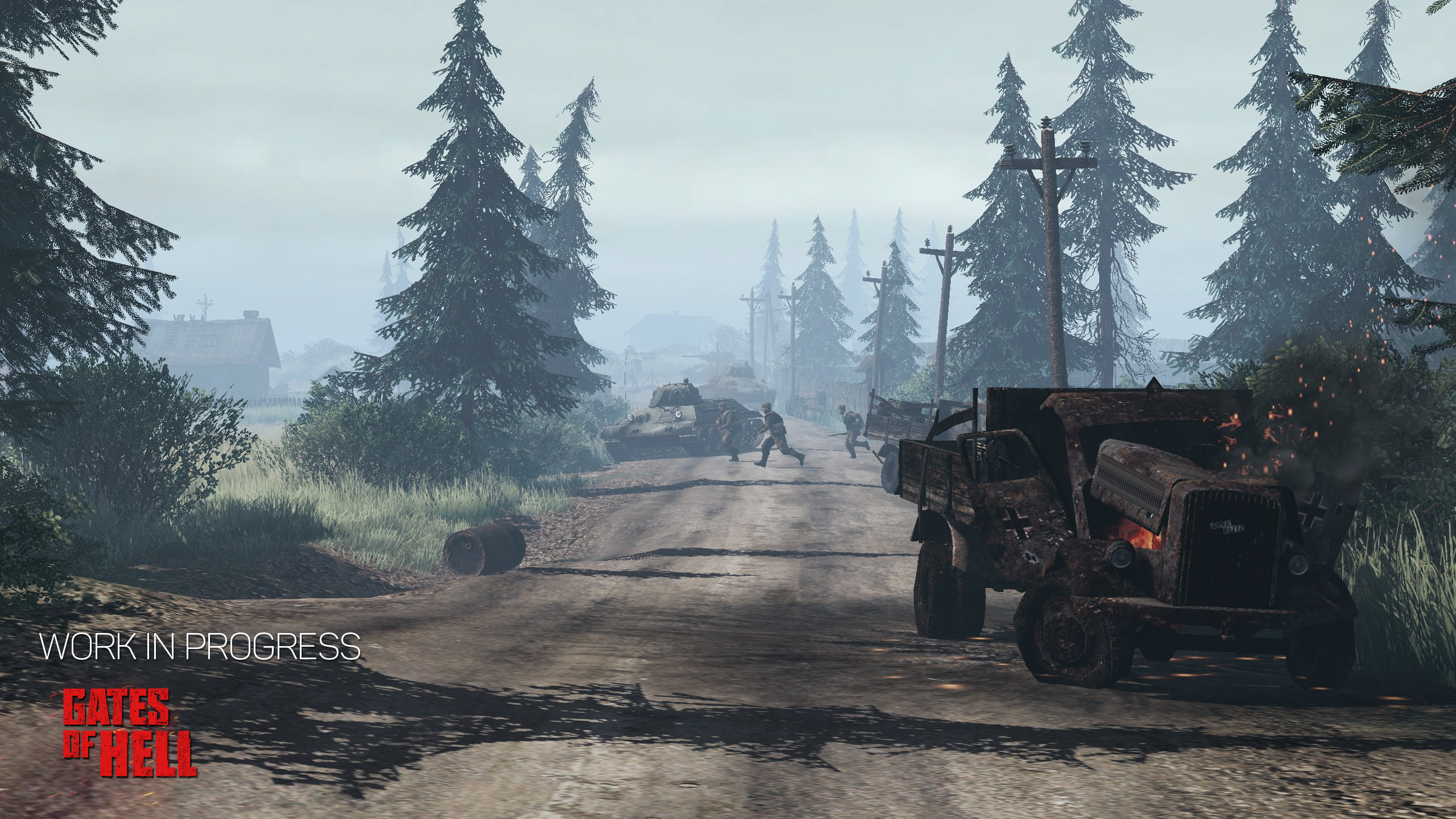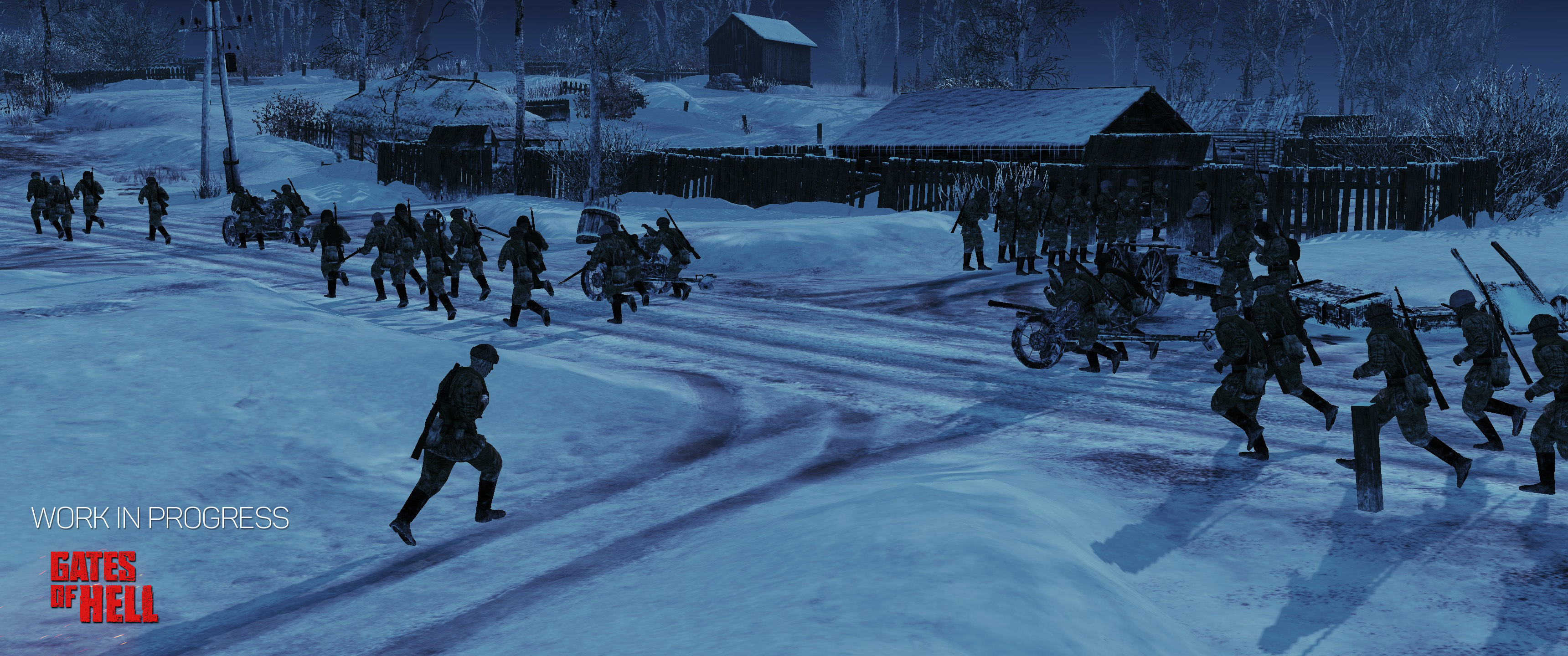Devblog #75: Volokolamsk
 HD Link
HD LinkHi everyone, it is time for an update!
First, we would like to thank everyone who applied for the beta test. Subscription for the beta was closed as of 01-dec-2018. We will be sending all of the applicants a message in the next 2 weeks.
Meanwhile, We have been working on new scenarios and lots of other stuff. One of the things that we would like to show you is typical of what we want for Gates of Hell, in terms of scenario building and realism; a truly hellish and epic battle.
This battle took place in the autumn of 1941 and marked the farthest point of advance of the Germans during “Operation Typhoon”. We have a super realistic map and scenario for you. But before we show you anything, let’s go back to the freezing cold of 1941 and set the scene.
The battle at Volokolamsk
Near the town of Volokolamsk, close to Moscow, fighting develops near the end of october.
This will be the decisive part of operation Typhoon; the Germans must reach Moscow or get stuck in the gruesome winter weather without reaching the main goal of operation Barbarossa.
 HD Link
HD LinkThe rasputitsa may have been a slowing factor, but now German forces launch an attack on Volokolamsk, which is being defended by the Soviet 316th Rifle Division. This is a crucial fight; if the defenders fail, the Germans will be able to reach nearby Moscow virtually unopposed. The stakes are high, but supplies are low.
The Soviets do everything to stop the German advance. The Germans, from their side, are pushing like hell in an attempt to take Moscow; they desperately need quick results. They can only use one road and they know it. The defenders know it, too.
The scenario
So here you are, commanding the last men of the 316th Rifle Division that retreated from Volokolamsk. It just started snowing. Civilians have toiled through the ice cold day to build defensive positions. They have now gone and it’s time for you to man the trenches.
But you have to do it NOW! Tank sounds up ahead are getting louder. Tell your men: not a single step back!
 HD Link
Soviet defense plan
HD Link
Soviet defense plan The mission in Gates of Hell
At the break of day, the first artillery barrage destroys the Soviet dummy AT guns. Then, the first combined tank/ infantry attack takes place.
Russian artillery rains down on the attack, but Stukas force the artillery crews to withdraw and take cover.
The German tanks are being stopped by the 316th’s AT guns and AT rifles, and they withdraw as well.
A second German artillery bombardment begins; this time it hits the trenches, killing the majority of Soviet soldiers.
The few survivors are now the only ones left to fend off the attack, which they barely do.
 HD Link
HD Link
 HD Link
The 316th moves into position during the night and digs in.
HD Link
The 316th moves into position during the night and digs in. HD Link
HD Link
 HD Link
Then the Germans arrive and storm their position. The 316th fights back.
HD Link
Then the Germans arrive and storm their position. The 316th fights back.So what’s the real story?
In real life, Volokolamsk fell on October 27th 1941 and the 316th were forced to fall back to the east of the town. The division’s 1075th rifle regiment set up defences at Dubosekovo railroad station. On the morning of 16th November they were attacked by the German 2nd Panzer Division, and by 10am the German forces had control of the villages of Petelino and Nelidovo. It is reported that they managed to destroy "some" tanks and suffered over 100 casualties.
The 316th had some 130 men left, who were also ordered to dig trenches at the Dubosekovo railway station. The only anti- tank weapons they had left were a few light AT guns and molotov cocktails. For a few days, they were at work digging trenches and setting up dummy AT guns and emplacements with the help of locals; they hoped that these would fool the enemy recon aircraft and draw a lot of fire. This would turn out to be true.
The first German attack came and went; German artillery bombed the defenses and a second attack was launched; by this time, there were only 28 men left to fight off this local attack. Only a few survived. The Germans held Volokolamsk for a while but in the end, operation Typhoon failed here because on december 20th the Soviet 331st rifle division drove the Germans out of Volokolamsk during the great winter offensive, which had started on december 5th.
Panfilov's Men
Panfilov's Men are described in Wikipedia as “a group of soldiers from the Red Army's 316th Rifle Division who took part in the defense of Moscow during World War II. According to official Soviet history, they were all killed in action on 16 November 1941, after destroying 18 German tanks and stopping the enemy attack on Volokolamsk. The Twenty-Eight were collectively endowed with the title Hero of the Soviet Union.”
So far, so good! This is one of those stories we must base our scenario on, right?
Not really. After the war it turned out that the story was a fabrication. It was impossible to tell what the 28 men had really achieved, since only 2 German tanks were reported destroyed that day. Worse still, one of the survivors was taken prisoner but escaped, and later volunteered for the German local militia in his home town to escape deportation.
Looking at the battle and the outcome, it has to be said that the 316th put up a truly fierce and heroic defence at Volokolamsk - Panfilov or no Panfilov.
Did you know?
- Many Soviet and German medal registers survived the war. Because of that, medals that are found post- war in some cases can help identify the original owner.
- In the original German planning for Barbarossa, the capture of Moscow was supposed to happen within 4 months after the start, so before the end of october.
- Some sources state that British Matilda tanks were used in the defense of Volokolamsk.
- One week after the Volokolamsk battle, the big Soviet winter counteroffensive started. It used troops which had been moved away from the east, after soviet intelligence confirmed that the Japanese had decided not to attack Russia, and that the attack on Pearl Harbor was imminent.